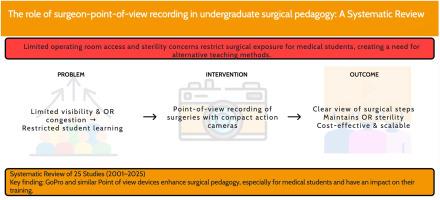The role of surgeon-point-of-view recording in undergraduate surgical pedagogy: A Systematic Review
Q2 Medicine
引用次数: 0
Abstract
Background
The Indian medical curriculum recently included Early Clinical Exposure (ECE) to enhance the undergraduate medical training. A key challenge in in implementing it in surgical education is to ensure adequate operating room (OR) exposure, while maintaining sterility and minimizing the OR traffic. Traditional teaching methods such as surgical simulators and virtual dissecting tables provide anatomical insights but lack the immersive experience of an actual OR setting. Intraoperative video recordings, particularly using compact and surgeon-controlled devices like GoPro cameras, offer an effective alternative for augmenting the surgical training. This study intends to assess the scope of recording technologies in enhancing undergraduate medical education in the surgical subjects.
Methodology
This study was registered in PROSPERO database and the registration number is CRD420251049770.A systematic review was performed in accordance with the Preferred Reporting Items for Systematic Reviews and Meta-Analyses (PRISMA) guidelines.
A comprehensive search of PubMed, Embase, and Google Scholar was performed using MeSH and non-MeSH terms related to surgical recording technologies. Articles describing the use of head-mounted or point-of-view cameras like GoPro or Google Glass, for live teaching and surgical training were included, while those using instrument-mounted cameras (e.g., arthroscope, endoscope) or hypothetical discussions were excluded. Data extraction focused on the type and number of cameras used, their purpose, and the target audience.
Results
A total of 1472 articles on surgical video recording were identified. Following the elimination of duplicates, 964 records were evaluated, resulting in the exclusion of 818 based on title and abstract analysis. Following full-text evaluation of 146 articles, 25 studies met the inclusion criteria. The majority of studies were conducted in general surgery and orthopaedics (n = 7), followed by neurosurgery (n = 4). Overhead camera systems were used in 21 studies, while tripod-mounted cameras were used in three studies. Most studies employed GoPro Hero 4, 5, and 6 models. The studies primarily focused on undergraduate teaching (n = 19), with some evaluating postgraduate training (n = 3).
Conclusion
Head-mounted recording devices, such as GoPro cameras, provide an effective, cost-efficient, and easily implementable tool for surgical instruction. They enhance undergraduate training by offering a OR exposure perspective while maintaining sterility and reducing OR congestion. The integration of sports camera-based intra operative recording should be considered a standard component of practical instruction in medical schools to improve surgical education and training outcomes.

外科医生视角记录在本科外科教学中的作用:系统综述
印度医学课程最近包括早期临床接触(ECE),以加强本科医学培训。在外科教育中实施它的一个关键挑战是确保足够的手术室(OR)暴露,同时保持无菌和尽量减少手术室流量。传统的教学方法,如手术模拟器和虚拟解剖台,提供解剖学的见解,但缺乏实际手术室环境的沉浸式体验。术中视频记录,特别是使用GoPro相机等紧凑的外科控制设备,为增强手术训练提供了有效的替代方案。本研究旨在探讨记录技术在外科本科医学教育中的应用范围。本研究在PROSPERO数据库注册,注册号为CRD420251049770。按照系统评价和荟萃分析的首选报告项目(PRISMA)指南进行系统评价。使用与手术记录技术相关的MeSH和非MeSH术语,对PubMed、Embase和谷歌Scholar进行了全面的搜索。描述使用头戴式或视点摄像机(如GoPro或谷歌Glass)进行现场教学和手术培训的文章被包括在内,而使用仪器安装式摄像机(如关节镜、内窥镜)或假定性讨论的文章被排除在外。数据提取的重点是所使用的摄像机的类型和数量、它们的用途和目标受众。结果共检索到手术录像1472篇。在消除重复之后,评估了964条记录,根据标题和摘要分析排除了818条记录。在对146篇文章进行全文评估后,有25篇研究符合纳入标准。大多数研究在普外科和骨科进行(n = 7),其次是神经外科(n = 4)。在21项研究中使用了头顶摄像机系统,而在3项研究中使用了三脚架摄像机。大多数研究采用GoPro Hero 4、5和6模型。这些研究主要集中在本科教学方面(n = 19),也有一些研究评估研究生培养(n = 3)。结论头戴式记录设备,如GoPro摄像机,是一种有效、经济、易于实施的手术指导工具。他们通过提供一个手术室暴露的角度来加强本科培训,同时保持无菌和减少手术室拥挤。整合基于运动摄像机的术中记录应被视为医学院实践教学的标准组成部分,以改善外科教育和培训结果。
本文章由计算机程序翻译,如有差异,请以英文原文为准。
求助全文
约1分钟内获得全文
求助全文
来源期刊

Journal of Clinical Orthopaedics and Trauma
Medicine-Orthopedics and Sports Medicine
CiteScore
4.30
自引率
0.00%
发文量
181
审稿时长
92 days
期刊介绍:
Journal of Clinical Orthopaedics and Trauma (JCOT) aims to provide its readers with the latest clinical and basic research, and informed opinions that shape today''s orthopedic practice, thereby providing an opportunity to practice evidence-based medicine. With contributions from leading clinicians and researchers around the world, we aim to be the premier journal providing an international perspective advancing knowledge of the musculoskeletal system. JCOT publishes content of value to both general orthopedic practitioners and specialists on all aspects of musculoskeletal research, diagnoses, and treatment. We accept following types of articles: • Original articles focusing on current clinical issues. • Review articles with learning value for professionals as well as students. • Research articles providing the latest in basic biological or engineering research on musculoskeletal diseases. • Regular columns by experts discussing issues affecting the field of orthopedics. • "Symposia" devoted to a single topic offering the general reader an overview of a field, but providing the specialist current in-depth information. • Video of any orthopedic surgery which is innovative and adds to present concepts. • Articles emphasizing or demonstrating a new clinical sign in the art of patient examination is also considered for publication. Contributions from anywhere in the world are welcome and considered on their merits.
 求助内容:
求助内容: 应助结果提醒方式:
应助结果提醒方式:


